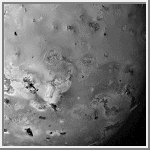|
COMETS EARTH JUPITER KUIPER BELT MARS MERCURY METEORITES NEPTUNE OORT CLOUD PLUTO SATURN SOLAR SYSTEM SPACE SUN URANUS VENUS ORDER PRINTS
PHOTO CATEGORIES SCIENCEVIEWS AMERICAN INDIAN AMPHIBIANS BIRDS BUGS FINE ART FOSSILS THE ISLANDS HISTORICAL PHOTOS MAMMALS OTHER PARKS PLANTS RELIGIOUS REPTILES SCIENCEVIEWS PRINTS
|
Related Document
Download Options
Shown here is one of the highest-resolution images of Io (Latitude: -60 to +20 degrees, Longitude: 150 to 230 degrees) acquired by the Galileo spacecraft, revealing a great variety of landforms. There are rugged mountains several miles high, layered materials forming plateaus, and many irregular depressions called volcanic calderas. Similar landforms were seen near Io's south pole by the Voyager spacecraft, but Galileo has revealed that such landforms are ubiquitous. Several of the dark, flow-like features correspond to hot spots, and may be active lava flows. There are no landforms resembling impact craters, as the volcanism covers the surface with new deposits much more rapidly than the flux of comets and asteroids can create large impact craters. North is to the top of the picture and the sun illuminates the surface from the left. The image covers an area 2000 kilometers wide and the smallest features that can be discerned are 2.5 kilometers in size. This image was taken on November 6th, 1996, at a range of 245,719 kilometers by the Solid State Imaging (CCD) system on the Galileo Spacecraft. Launched in October 1989, Galileo entered orbit around Jupiter on December 7, 1995. The spacecraft's mission is to conduct detailed studies of the giant planet, its largest moons and the Jovian magnetic environment. The Jet Propulsion Laboratory, Pasadena, CA manages the mission for NASA's Office of Space Science, Washington, DC. |
